I am writing my own midpoint displacement algorithm for learning purposes and I decided to implement it in my own way to see if I was 1) able to understand the algorithm and 2) see if i could modify it to my liking.
here is the code to generate the fractal:
public void Generate(Double rg, int size)
{
Random rand = new Random();
int min = -127;
int max = 128;
// Starting points of the rectangle
MDP_Point s1 = new MDP_Point(0, 0, rand.Next(min, max));
MDP_Point s2 = new MDP_Point(size, 0, rand.Next(min, max));
MDP_Point s3 = new MDP_Point(size, size, rand.Next(min, max));
MDP_Point s4 = new MDP_Point(0, size, rand.Next(min, max));
// Lists containing the rectangles
List<MDP_Rect> newRect = new List<MDP_Rect>(); // Newly created rectangles
List<MDP_Rect> oldRect = new List<MDP_Rect>(); // Rectangles being divided
// Starting rectangle is added to the list
oldRect.Add(new MDP_Rect(s1, s2, s3, s4));
// Distance between 2 points in a rectangle
int h = size;
while (h > 1)
{
foreach (MDP_Rect r in oldRect)
{
// Middle points of rectangle segments
MDP_Point m1 = new MDP_Point();
MDP_Point m2 = new MDP_Point();
MDP_Point m3 = new MDP_Point();
MDP_Point m4 = new MDP_Point();
// Middle point of rectangle
MDP_Point mm = new MDP_Point();
m1.x = (r.C1.x + r.C2.x) / 2;
m1.y = (r.C1.y + r.C2.y) / 2;
m1.z = ((r.C1.z + r.C2.z) / 2) +(rand.Next(min, max) * rg);
m2.x = (r.C2.x + r.C3.x) / 2;
m2.y = (r.C2.y + r.C3.y) / 2;
m2.z = ((r.C2.z + r.C3.z) / 2) +(rand.Next(min, max) * rg);
m3.x = (r.C3.x + r.C4.x) / 2;
m3.y = (r.C3.y + r.C4.y) / 2;
m3.z = ((r.C3.z + r.C4.z) / 2) +(rand.Next(min, max) * rg);
m4.x = (r.C1.x + r.C4.x) / 2;
m4.y = (r.C1.y + r.C4.y) / 2;
m4.z = ((r.C1.z + r.C4.z) / 2) + (rand.Next(min, max) * rg);
mm.x = (r.C1.x + r.C2.x + r.C3.x + r.C4.x) / 4;
mm.y = (r.C1.y + r.C2.y + r.C3.y + r.C4.y) / 4;
mm.z = ((r.C1.z + r.C2.z + r.C3.z + r.C4.z) / 4) + (rand.Next(min, max) * rg);
newRect.Add(new MDP_Rect(r.C1, m1, mm, m4));
newRect.Add(new MDP_Rect(m1, r.C2, m2, mm));
newRect.Add(new MDP_Rect(mm, m2, r.C3, m3));
newRect.Add(new MDP_Rect(m4, mm, m3, r.C4));
}
oldRect.Clear();
oldRect = new List<MDP_Rect>(newRect);
newRect.Clear();
h /= 2;
}
List<MDP_Rect> sorted = new List<MDP_Rect>();
sorted = oldRect.OrderBy(y => y.C1.y).ThenBy(x => x.C1.x).ToList();
List<MDP_Point> mapArray = new List<MDP_Point>();
mapArray.AddRange(CreateArray(sorted));
CreateImage(size, mapArray, rg);
}
MDP_Point only contains x, y and z values MDP_Rectangle contains 4 points, creating a rectangle
The CreateArray() method only takes the ordered rectangle list and outputs and list of points in the correct order to create an image.
CreateArray():
private List<MDP_Point> CreateArray(List<MDP_Rect> lRect)
{
List<MDP_Point> p = new List<MDP_Point>();
int size = (int)Math.Sqrt(lRect.Count);
int i = 0;
foreach (MDP_Rect r in lRect)
{
p.Add(new MDP_Point((int)r.C1.x, (int)r.C1.y, (int)r.C1.z));
if (i > 0 && i % size == size - 1)
{
p.Add(new MDP_Point((int)r.C2.x, (int)r.C2.y, (int)r.C2.z));
}
i++;
}
for (int a = 0; a < size; a++)
{
p.Add(new MDP_Point((int)lRect[(size * size - size) + a].C4.x,
(int)lRect[(size * size - size) + a].C4.y,
(int)lRect[(size * size - size) + a].C4.z));
if (a > 0 && a % size == size - 1)
{
p.Add(new MDP_Point((int)lRect[(size * size - size) + a].C3.x,
(int)lRect[(size * size - size) + a].C3.y,
(int)lRect[(size * size - size) + a].C3.z));
}
}
return p;
}
This is the method to create the image:
private void CreateImage(int size, List<MDP_Point> arr, double roughness)
{
Bitmap map = new Bitmap(size, size);
int ver = 0;
for (int i = 0; i < map.Height; i++)
{
for (int n = 0; n < map.Width; n++ )
{
int h = (int)arr[ver].z + 127;
if (h < 0)
{
h = 0;
}
else if (h > 255)
{
h = 255 ;
}
Color c = Color.FromArgb(h, h, h);
//map.SetPixel(n, i, c);
map.SetPixel(i, n, c);
ver++;
}
}
Bitmap m = new Bitmap(map);
bool saved = true;
int num = 0;
while (saved)
{
if (File.Exists("map_S" + size + "_R" + roughness + "_" + num + ".png"))
{
num++;
}
else
{
m.Save("map_S" + size + "_R" + roughness + "_" + num + ".png", System.Drawing.Imaging.ImageFormat.Png);
saved = false;
}
}
map.Dispose();
m.Dispose();
}
The fact that any value below 0 is set to 0 and any value above 255 is set to 255 is probably a big issue.... not sure what to do about it.
Here's an image generated by the code: Size: 1024 Roughness: 0.5

The most obvious issues are the diagonal "ridge lines" and the tiled look there is.
At this point, i'm not sure what to do to fix this to make it look more natural. Any ideas?

